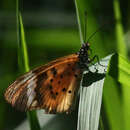mk
имиња во трошки


Acraea encedon, the common acraea, white-barred acraea or encedon acraea, is a butterfly of the family Nymphalidae. It is found in sub-Saharan Africa and south-western Arabia.[3] It is one of the species of Acraea sometimes separated in Telchinia.
The wingspan is 40–50 mm (1.6–2.0 in), with the female being slightly larger than the male, but otherwise similar in pattern and colour. The apex of the forewing is blackish and divided by a white bar. The rest of the surface of the wings are usually orange with black spots, however paler varieties with a greyish or yellowish base colour are also found.
The butterfly is a polymorphic Müllerian mimic of Danaus chrysippus, which is a highly unusual phenomenon as Müllerian mimicry is almost always monomorphic.

A. encedon is a very variable and widely distributed species and appears in many forms but with no definite local races. The black dots are the same in all the forms and are arranged as follows. Fore wing: 1 or 2 basal dots in 1b; a transverse spot in the cell; discal dots in 1b to 6, of which that in 1b is often double and always placed much nearer to the distal margin than the one in 2; in the forms with black apex discal dots 3 to 6 on the upper surface are indistinct against the dark ground-colour. Hindwing: basal dots in (1a), 1b, 1c and 7; 1 or 2 dots in the cell; one dot each in the basal angle of cellules 4 and 5 and discal dots in 1b to 7, of which the one in 3 or 4 is placed nearer to the distal margin than the rest and the one in 2 nearer to the base than that in 1b. The hindwing above has a narrow black or blackish marginal band 1 to 2 mm. in breadth, beneath the streaks on the interneural folds are often red-yellow instead of black. Throughout Africa south of the Sahara and Madagascar.
The following forms differ from the preceding in having the apical half of the forewing above not or scarcely darker than the basal half, with distinct black discal dots.
Larva slate-black with yellow lateral line, small white and yellow dorsal spots edged with black, and black spines; head black. Pupa white with the usual black markings. The larva lives on Commelina.
The agreement in colour and markings between the forms of Acraea encedon and those of the much larger Danaus chrysippus and D. dorippus is very remarkable. Compare A. encedon and D. chrysippus, A. alcippina and D. alcippus, A. daira and D. dorippus, A. radiata and D. dorippus ab. albinus.[4]
There are two subspecies:
The eggs are oval in shape. The larvae feed on Commelina species, such as C. diffusa. The flight period of the adults is all year, but they are most common from March to May. They are slow fliers, and perch on low-growing vegetation.
In some populations there are two kinds of females, one producing offspring in a normal 1:1 sex ratio, the other producing females only. In other populations the sex ratio is apparently normal. Scientists first believed the distorted sex-ratio was caused by a driving W chromosome. Later research suggests it is caused by cytoplasmic bacteria.
Mounted specimen from Eritrea
Imago in Benin
Larva of the nominate subspecies, KwaZulu-Natal
It is a member of the Acraea encedon species group, but see also Pierre & Bernaud, 2014[5]
Acraea encedon, the common acraea, white-barred acraea or encedon acraea, is a butterfly of the family Nymphalidae. It is found in sub-Saharan Africa and south-western Arabia. It is one of the species of Acraea sometimes separated in Telchinia.
Actinote encedon is een vlinder uit de familie van de Nymphalidae.[1] De wetenschappelijke naam van de soort is voor het eerst geldig gepubliceerd in 1758 door Carl Linnaeus.
Deze vlindersoort komt voor in Afrika bezuiden de Sahara langs met riet begroeide oevers van rivieren en beken.
De waardplant van de rups is de giftige Commelina.
Deze vlinder scheidt bij aanraking een gelige, schuimende vloeistof uit, waarin zich het uiterst giftige blauwzuur bevindt. Deze stof komt niet uit de waardplant van de rups, maar wordt door de vlinder zelf aangemaakt.
Bronnen, noten en/of referentiesActinote encedon is een vlinder uit de familie van de Nymphalidae. De wetenschappelijke naam van de soort is voor het eerst geldig gepubliceerd in 1758 door Carl Linnaeus.